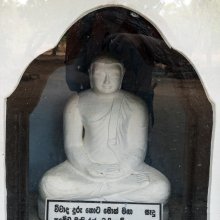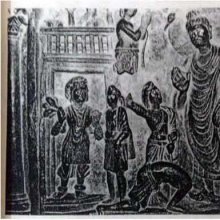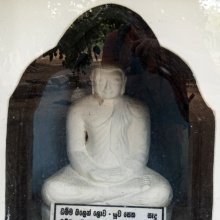Sumedha, Sumedhā: 13 definitions
Introduction:
Sumedha means something in Buddhism, Pali, Hinduism, Sanskrit, Marathi. If you want to know the exact meaning, history, etymology or English translation of this term then check out the descriptions on this page. Add your comment or reference to a book if you want to contribute to this summary article.
Images (photo gallery)
In Hinduism
Vaishnavism (Vaishava dharma)
Source: humindian: 108 names of Lord KrishnaOne of the 108 names of Krishna; Meaning: "Intelligent Lord"

Vaishnava (वैष्णव, vaiṣṇava) or vaishnavism (vaiṣṇavism) represents a tradition of Hinduism worshipping Vishnu as the supreme Lord. Similar to the Shaktism and Shaivism traditions, Vaishnavism also developed as an individual movement, famous for its exposition of the dashavatara (‘ten avatars of Vishnu’).
Purana and Itihasa (epic history)
Source: Wisdom Library: Varāha-purāṇaSumedhā (सुमेधा).—Name of a river (nadī) situated near the seven great mountains on the western side of mount Naiṣadha, according to the Varāhapurāṇa chapter 83. These settlements consume the water flowing from these seven great mountains (Viśākha, Kambala, Jayanta, Kṛṣṇa, Harita, Aśoka and Vardhamāna). Niṣadha (Naiṣadha) is one of the seven mountains located in Jambūdvīpa, ruled over by Āgnīdhra, a grandson of Svāyambhuva Manu, who was created by Brahmā, who was in turn created by Nārāyaṇa, the unknowable all-pervasive primordial being.
Source: Cologne Digital Sanskrit Dictionaries: The Purana Index1a) Sumedha (सुमेध).—A son of Jaigiṣavya, an avatār of the Lord.*
- * Vāyu-purāṇa 23. 139.
1b) A mountain to the east of Aruṇoda where Ādityas and Vasus live.*
- * Vāyu-purāṇa 36. 19; 37. 26; 39. 48.
1c) A god of Sumedhasa group.*
- * Brahmāṇḍa-purāṇa II. 36. 60.
1d) Rājaṛṣi; a tapas siddha.*
- * Vāyu-purāṇa 57. 122.
1e) A sage of the Cākṣuṣa epoch.*
- * Viṣṇu-purāṇa III. 1. 28.
1f) Medha, Medhatithi, Satyamedha, Pṛśnimedha, Alpamedha, Dīptimedha, Yaśomedha, Sthiramedha, Sarvamedha, Aśvamedha, Pratimedha, Medhavat and Medhaharta.*
- * Vāyu-purāṇa 62. 51-2.
2a) Sumedhā (सुमेधा).—A daughter of Sukanyā and Cyavana: wife of Nidhurva and mother of Kuṇḍa pāyins.*
- * Brahmāṇḍa-purāṇa III. 8. 31; Vāyu-purāṇa 70. 26.
2b) A R. of the Ketumālā country.*
- * Vāyu-purāṇa 44. 17.
Sumedhā (सुमेधा) is the wife of Naidhruva: one of the two sons of Vatsara and grandson of Dakṣa, according to one account of Vaṃśa (‘genealogical description’) of the 10th century Saurapurāṇa: one of the various Upapurāṇas depicting Śaivism.—Accordingly, [...] Kaśyapa created the animals, animates and inanimates and again for the growth of progeny he underwent austere penance. By the power of penance two sons namely Vatsara and Asita were born. From Vatsara two sons were born namely Naidhruva and Raivya. Sumedhā gave birth to sons called Kuṇḍapāyin from Naidhruva.

The Purana (पुराण, purāṇas) refers to Sanskrit literature preserving ancient India’s vast cultural history, including historical legends, religious ceremonies, various arts and sciences. The eighteen mahapuranas total over 400,000 shlokas (metrical couplets) and date to at least several centuries BCE.
In Buddhism
Theravada (major branch of Buddhism)
Source: Pali Kanon: Pali Proper Names1. Sumedha. The Bodhisatta in the time of Dipankara Buddha. He was a very rich brahmin of Amaravati, and, having left the world, became an ascetic of great power in the Himalaya. While on a visit to Rammma nagara, he saw people decorating the road for Dipankara Buddha, and undertook to do one portion of the road himself. The Buddha arrived before his work was finished, and Sumedha lay down on a rut for the Buddha to walk over him. He resolved that he, too, would become a Buddha, and Dipankara, looking into the future, saw that his wish would come true. This was the beginning of Gotama Buddhas qualification for Enlightenment. J.i.2ff.; DhA.i.68; Bu.ii.5ff.; SNA.i.49; in Chinese Records he is called Megha. The Dvy. (p.247) calls him Sumati.
2. Sumedha. A khattiya, father of Dipankara Buddha. J.i.29; Bu.ii.207.
3. Sumedha. A khattiya, father of Narada Buddha. J.i.37; but Bu.x.18 calls him Sudeva.
4. Sumedha. The eleventh of the twenty four Buddhas.
He was born in Sudassana, his father being the khattiya Sudatta and his mother Sudatta. He lived in the household for nine thousand years, in three palaces, Sucanda, Kancana (Konca) and Sirivaddha, his wife being Sumana and his son Sumitta (Punabbasumitta). He left home on an elephant, practised austerities for eight months, was given a meal of milk rice by Nakula, and grass for his seat by the Ajivaka Sirivaddha. He obtained Enlightenment under a mahanimba(mahanipa)-tree. His body was eighty eight cubits in height. His chief disciples were Sarana and Sabbakama among monks and Rama and Surama among women. Sagara was his personal attendant. His chief lay patrons were Uruvela and Yasava among men, and Yasodhara and Sirima among women. He preached his first sermon at Sudassana, to his younger brothers. The Bodhisatta was the ascetic, Uttara. Sumedha lived for ninety thousand years and died in Medharama. His relics were scattered. Bu.xii.??; BuA.163f.5. Sumedha. The name of a brahmin family in the time of Tissa Buddha. Varana Thera was born in the family. ThagA.i.353.
6. Sumedha. An upatthaka of Sumedha Buddha, whom Pilindavaccha met at that time. Ap.i.59; but see Bu.xii.23, where Sumedhas upatthaka is called Sagara. Perhaps this refers to another.
7. Sumedha. A king of twenty kappas ago, a previous birth of Avopphiya Thera. Ap.i.112.
8. Sumedha. A king of seven kappas ago, a previous birth of Padasannaka Thera. Ap.i.119.
9. Sumedha. An Elder of Ceylon, at whose request Buddhanaga wrote the Vinayatthamanjusa. P.L.C. 201.
10. Sumedha. A Thera of Cutaggama, probably of the fourteenth century; author of the Sadhucaritodaya and the Anapattidipani. P.L.C.247.
-- or --
1. Sumedha Theri. She was the daughter of King
Konca of Mantavati. Theravāda is a major branch of Buddhism having the the Pali canon (tipitaka) as their canonical literature, which includes the vinaya-pitaka (monastic rules), the sutta-pitaka (Buddhist sermons) and the abhidhamma-pitaka (philosophy and psychology).
Mahayana (major branch of Buddhism)
Source: Wisdom Library: Maha Prajnaparamita Sastra1) Sumedha (सुमेध).—A young student (brahmacarin) or novice (māṇava) named Sumedha, Megha or Sumati, according to various sources, bought from a maiden five of the seven blue lotus flowers which she had. He threw them as an offering to the Buddha Dīpaṃkara who was passing by, and the lotuses remained suspended in the air around the Buddha’s head. Converted by this miracle, the young man then laid out on the muddy ground the antelope skin which served as his garment and spread out his long hair as a mat; prostrating thus, he pronounced the solemn vow that he would also become Buddha. Then Dīpaṃkara predicted that he would one day become Buddha under the name Śākyamuni. This legend is attested by a large number of sources
2) Sumedhā (सुमेधा) is the name of a Bhikṣuṇī, according to the Sumedhājātaka, as mentioned in chapter L.—Accordingly, “thus Siu-mi-t’o pi-k’ieou-ni (Sumedhā Bhikṣuṇī) along with two co-disciples, built a vihāra for the Buddha Kia-na-k’ie-meou-ni (Kanakamuni) and, for numberless incalculable thousands of myriads of lifetimes, enjoyed bliss among the noble Cakravartin kings and the Devarājas”.
Notes: The successive lives of Sumedhā are told in the Therīgathās, and their commentary: Psalms of the Sisters as well as in the Apadāna. Under the Buddha Koṇāgamana, [Sumedhā] and two of her companions, Dhanañjānī and Khema, made a gift of a vihāra to the teacher. Under the Buddha Kassapa, [Sumedhā] was a friend of the seven daughters of king Kiki of Benares and, as an Upāsikā, was noted for her generosity which won her rebirth among the gods for innumerable times. Finally, under the Buddha Śākyamuni, [Sumedhā] was the daughter of king Koñca of Mantāvatī. She refused the hand of Anikadatta, king of Vāraṇavatī, whom her parents wished her to accept. After having converted her family and her entourage, full of distaste for the world, she left home and became a nun. Shortly after, she attained Arhathood.

Mahayana (महायान, mahāyāna) is a major branch of Buddhism focusing on the path of a Bodhisattva (spiritual aspirants/ enlightened beings). Extant literature is vast and primarely composed in the Sanskrit language. There are many sūtras of which some of the earliest are the various Prajñāpāramitā sūtras.
Languages of India and abroad
Pali-English dictionary
Source: BuddhaSasana: Concise Pali-English Dictionarysumedha : (adj.) wise.

Pali is the language of the Tipiṭaka, which is the sacred canon of Theravāda Buddhism and contains much of the Buddha’s speech. Closeley related to Sanskrit, both languages are used interchangeably between religions.
Marathi-English dictionary
Source: DDSA: The Molesworth Marathi and English Dictionarysumēdhā (सुमेधा).—a S Sensible, intelligent, of good capacity or understanding.
Source: DDSA: The Aryabhusan school dictionary, Marathi-Englishsumēdhā (सुमेधा).—a Sensible, of good understanding or capacity.
Marathi is an Indo-European language having over 70 million native speakers people in (predominantly) Maharashtra India. Marathi, like many other Indo-Aryan languages, evolved from early forms of Prakrit, which itself is a subset of Sanskrit, one of the most ancient languages of the world.
Sanskrit dictionary
Source: Cologne Digital Sanskrit Dictionaries: Edgerton Buddhist Hybrid Sanskrit DictionarySumedhā (सुमेधा).—(= Pali id.), name of a nun: Karmavibhaṅga (and Karmavibhaṅgopadeśa) 96.6.
Source: Cologne Digital Sanskrit Dictionaries: Cappeller Sanskrit-English DictionarySumedha (सुमेध).—[adjective] pithy, strong.
Source: Cologne Digital Sanskrit Dictionaries: Monier-Williams Sanskrit-English Dictionary1) Sumedha (सुमेध):—[=su-medha] [from su > su-ma] mf(ā)n. very nourishing, loamy (as pasture land), [Ṛg-veda]
2) [v.s. ...] (-medha), [probably] = next, [Ṛg-veda x, 132, 7.]
[Sanskrit to German]
Sanskrit, also spelled संस्कृतम् (saṃskṛtam), is an ancient language of India commonly seen as the grandmother of the Indo-European language family (even English!). Closely allied with Prakrit and Pali, Sanskrit is more exhaustive in both grammar and terms and has the most extensive collection of literature in the world, greatly surpassing its sister-languages Greek and Latin.
See also (Relevant definitions)
Partial matches: Medha, Cu, Shu.
Starts with: Sumedhakatha, Sumedhas, Sumedhasa, Sumedhayasa.
Ends with: Pashumedha.
Full-text (+73): Sumedhas, Saumedha, Abhishrava, Kundapayin, Nidhruva, Konca, Alpamedha, Praviloma, Medharama, Sumedhakatha, Dhananjani, Konagamana, Khema, Mantavati, Anikaratta, Padapithiya, Varanavati, Megha, Kiki, Saccakali.
Relevant text
Search found 40 books and stories containing Sumedha, Sumedhā, Sumēdhā, Su-medha; (plurals include: Sumedhas, Sumedhās, Sumēdhās, medhas). You can also click to the full overview containing English textual excerpts. Below are direct links for the most relevant articles:
Amaravati Art in the Context of Andhra Archaeology (by Sreyashi Ray chowdhuri)
Suruci Jātaka < [Chapter 3 - Amarāvatī and the Formative Stage of the Buddhist Art]
Resemblance to Gandhāra art < [Chapter 5 - Impact of Amarāvatī Art]
Religious background of early Andhra Pradesh < [Chapter 3 - Amarāvatī and the Formative Stage of the Buddhist Art]
The Skanda Purana (by G. V. Tagare)
Chapter 8 - The Greatness of Tulasī (Basil Plant) < [Section 4 - Kārttikamāsa-māhātmya]
Chapter 9 - The (Spiritual) Power of Simantinī < [Section 3 - Brāhmottara-khaṇḍa]
Chapter 23 - Installation of Someśvara (Soma-īśvara) < [Section 1 - Prabhāsa-kṣetra-māhātmya]
Apadana commentary (Atthakatha) (by U Lu Pe Win)
Commentary on the Biography of the thera Anuruddha < [Chapter 1 - Buddhavagga (Buddha section)]
Dipankara Buddha predicts Buddhahood for Sumedha < [Part 1 - Remote preface (dūre-nidāna)]
Introduction < [Part 1 - Remote preface (dūre-nidāna)]
The Great Chronicle of Buddhas (by Ven. Mingun Sayadaw)
Buddha Chronicle 1: Dīpaṅkarā Buddhavaṃsa < [Chapter 9 - The chronicle of twenty-four Buddhas]
Chapter 5 - The Prophecy < [Volume 1.1]
Buddha Chronicle 11: Sumedha Buddhavamasa < [Chapter 9 - The chronicle of twenty-four Buddhas]
Maha Prajnaparamita Sastra (by Gelongma Karma Migme Chödrön)
The Sumedhā-Jātaka < [I. Puṇyakriyāvastu consisting of generosity]
Appendix 2 - The legend of Dharmaruci < [Chapter XIII - The Buddha-fields]
Appendix 2 - The offering of the future Śākyamuni to the Buddha Dīpaṃkara < [Chapter VIII - The Bodhisattvas]
Rig Veda (translation and commentary) (by H. H. Wilson)
Related products



